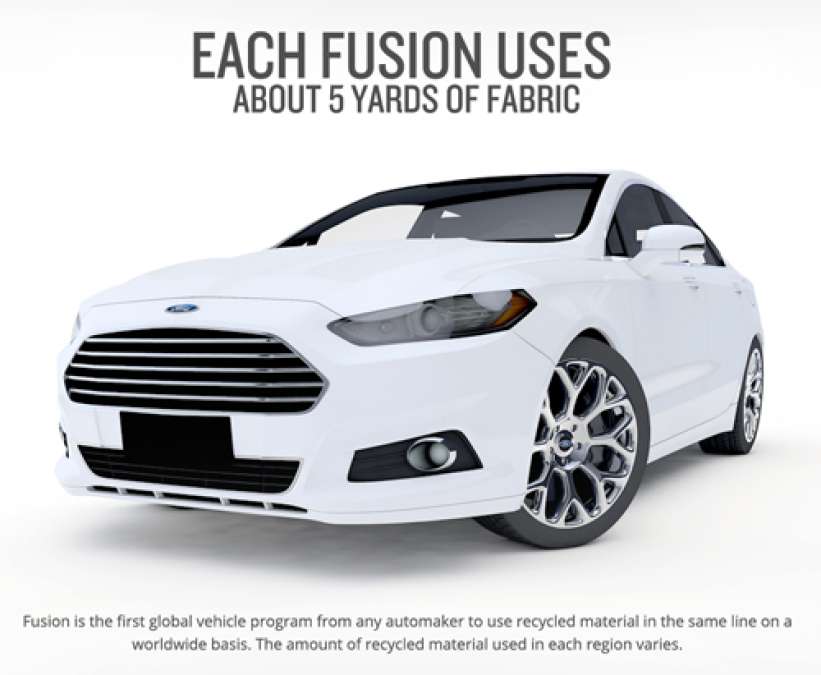Select models of the Ford Fusion in North America, along with Ford’s Mondeo Ambiente, retailed in Asia and the Pacific islands, are the latest vehicles to feature fabric made from recycled yarns.
Sales of this vehicle line, using plastic bottles and post-industrial waste to create new seat and upholstery coverings, will enable the production of 1.5 million yards of recycled content fabric annually.
Between 800,000 and 900,000 yards will be used for cars sold in the US alone.
“The fabric being used in Fusion truly illustrates Ford’s commitment to sustainability, regardless of any geographical borders,” says Robert Brown, vice president, sustainability, environment and safety engineering. “Anytime we can connect our supply and suppliers with sustainability, we’re headed in the right direction on our commitment to help better the world.”
Ford’s use of sustainable fabrics is growing as part of the firm’s global vehicle programs, as it continues implementing recycled material standards on its newer vehicles.
As the company identifies quality recycled yarn suppliers world wide, eventually all fabrics used in Ford vehicles will contain recycled content, according to Carol Kordich, Ford’s lead designer of sustainable materials.
Since 2009, the company has mandated that all Ford products feature seat fabrics containing at least 25 percent recycled material.
As production of such materials by industrial suppliers increases, the cost of such fabrics is likely to decrease, leading to the widespread use of recycled content fabrics by many more automakers.
Some Ford vehicles already have seats covers made of 100 percent recycled materials, demonstrating that more fuel efficient and alternative drivetrains are not the only way to make cars greener.
“Ford is definitely a leader and the only one in the automotive market to put a marker out there that we need to hit,” says Dan Russian, business manager at Sage Automotive Interiors, Ford’s largest fabric supplier in North America. “It was exciting to see Ford take a leadership position in the use of sustainable materials, which supported the efforts of our design and development teams.”
Fords demand for sustainable fabrics speeded up Sage’s development of recycled content fabrics for the automotive industry by five full years, making the firm a trailblazer on the path to a sustainable world.
Leading the charge, the Ford Escape Hybrid was the first vehicle to feature 100 percent recycled fabric seat covers in 2008. Today the Escape line not only has recycled yarn seats, but also contains soybean seat cushions, carpets made from plastic bottles and headliners that utilize post-consumer jeans and nylons.
The move began at the turn of the century, but automakers had trouble convincing recycled fabric manufacturers they were genuinely interested in making use of sustainable woven materials.
It took a lot of time to convince the source companies, according to Carol Kordich, Ford lead designer of sustainable materials, who joined the firm in 2000 with a background in interior architectural design.
Most such materials were used only in the apparel and contract markets field a decade ago.
“From my previous background I knew companies like Unifi and Sage were innovating products to further push the envelope in sustainable developments,” says Kordich. “Collaborating with companies that have the same mindset as Ford helped take us to the next level much faster.”
To cut costs, Kordich worked a deal with Unifi and Sage on a plan requiring Unifi to provide REPREVE, a yarn made from post-industrial and post-consumer leftovers, to Sage, who would make seat fabric, selling any trimmings or bad dye lots back to Unifi for reprocessing.
Ford would also help collect clear, plastic water bottles for the REPREVE Recycling Center. Ford is collecting 2 million plastic bottles to send to Unifi and every Fusion repurposes up to 40 clear, plastic water bottles.
By closing the loop, this solution kept costs down, helping Ford to produce products in support of its commitment to quality and the environment.
This REPREVE-based fabric made its debut in the 2011 Focus Electric.
“We are off to a good start,” Kordich said.” But it’s only the beginning of our





